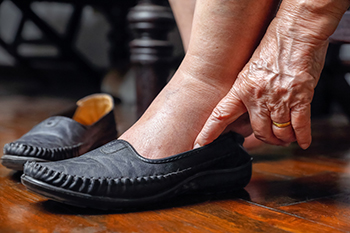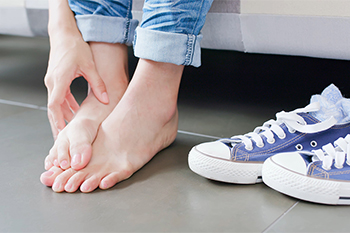October 2022
Finding Shoes for Problem Feet

Many problems with the feet, such as blisters, corns, and calluses, are either caused by or adversely affected by the type of shoes you wear. A shoe that fits well can not only help to alleviate foot pain, but also keep it from getting worse. The choice of proper footwear is largely dependent on knowing what is wrong with your feet. To find out exactly what you need, you may want to see a podiatrist, who is medically trained to deal with problems of the feet and ankles. The doctor can perform tests and examine the biomechanics of your feet to determine treatment options and offer guidance on footwear choices. If you have bone deformities, such as bunions or hammertoe, these must also be taken into account while making your footwear decisions. As a rule, when buying shoes it is a good idea to measure your feet accurately and purchase the size that fits the larger foot. If you need orthotics, inserts to correct problems such as fallen arches and overpronation, you will need to bring them with you as you try on shoes. If custom orthotics are necessary, your podiatrist can have them created to address your particular foot problems.
It is important to find shoes that fit you properly in order to avoid a variety of different foot problems. For more information about treatment, contact John Killough, DPM from Regional Foot Center. Our doctor will treat your foot and ankle needs.
Proper Shoe Fitting
Shoes have many different functions. They cushion our body weight, protect our feet, and allow us to safely play sports. You should always make sure that the shoes you wear fit you properly in order to avoid injuries and deformities such as: bunions, corns, calluses, hammertoes, plantar fasciitis, stress fractures, and more. It is important to note that although a certain pair of shoes might be a great fit for someone else, that doesn’t mean they will be a great fit for you. This is why you should always try on shoes before buying them to make sure they are worth the investment. Typically, shoes need to be replaced ever six months to one year of regular use.
Tips for Proper Shoe Fitting
- Select a shoe that is shaped like your foot
- Don’t buy shoes that fit too tight, expecting them to stretch to fit
- Make sure there is enough space (3/8” to ½”) for your longest toe at the end of each shoe when you are standing up
- Walk in the shoes to make sure they fit and feel right
- Don’t select shoes by the size marked inside the shoe, but by how the shoe fits your foot
The shoes you buy should always feel as good as they look. Shoes that fit properly will last longer, feel better, and improve your way of life each day.
If you have any questions, please feel free to contact our offices located in Charleston and Effingham, IL . We offer the newest diagnostic and treatment technologies for all your foot care needs.
Plantar Fasciitis in Bartenders

Plantar fasciitis is defined as the inflammation of the plantar fascia, which is a band of tissue that runs along the sole of your foot. Some individuals are more susceptible to plantar fasciitis because of the nature of their employment. Bartenders fall into this category. Throughout their shifts, it is common for bartenders to be on their feet throughout the day and to move constantly between different points along the bar. All of this activity can cause micro tears in the arch of the foot, which can result in heel pain and calf pain. Bartenders have several potential solutions at their disposal to mitigate pain from plantar fasciitis. For example, bartenders might invest in a highly supportive pair of shoes. Some bartenders prefer shoes that have a good grip but are also supportive in the arch of the foot to prevent plantar fasciitis. Consult with a podiatrist today if you are a bartender.
Plantar fasciitis can be very painful and inconvenient. If you are experiencing heel pain or symptoms of plantar fasciitis, contact John Killough, DPM from Regional Foot Center. Our doctor can provide the care you need to keep you pain-free and on your feet.
What Is Plantar Fasciitis?
Plantar fasciitis is the inflammation of the thick band of tissue that runs along the bottom of your foot, known as the plantar fascia, and causes mild to severe heel pain.
What Causes Plantar Fasciitis?
- Excessive running
- Non-supportive shoes
- Overpronation
- Repeated stretching and tearing of the plantar fascia
How Can It Be Treated?
- Conservative measures – anti-inflammatories, ice packs, stretching exercises, physical therapy, orthotic devices
- Shockwave therapy – sound waves are sent to the affected area to facilitate healing and are usually used for chronic cases of plantar fasciitis
- Surgery – usually only used as a last resort when all else fails. The plantar fascia can be surgically detached from the heel
While very treatable, plantar fasciitis is definitely not something that should be ignored. Especially in severe cases, speaking to your doctor right away is highly recommended to avoid complications and severe heel pain. Your podiatrist can work with you to provide the appropriate treatment options tailored to your condition.
If you have any questions please feel free to contact our offices located in Charleston and Effingham, IL . We offer the newest diagnostic and treatment technologies for all your foot and ankle needs.
Complications of Athlete’s Foot

Athlete’s foot is one of the many foot conditions that can reduce and diminish the health of your feet. Caused by a fungal infection, Athlete’s foot can facilitate the development of a rash between the toes. There are several complications of this condition to be aware of. First, if you have a case of athlete’s foot, it may be possible to develop a bacterial infection as well. This is especially common when the athlete’s foot is not addressed for some time. The bacterial infection can develop as a result of scratching at the affected area. Second, another important complication of athlete’s foot to be aware of is that it may spread to other parts of the body. For example, since athlete’s foot is contagious, if you are scratching the affected area, the fungal infection can spread to your hands, the groin, or underneath the nails. If you have athlete’s foot, contact a podiatrist today for treatment.
Athlete’s foot is an inconvenient condition that can be easily reduced with the proper treatment. If you have any concerns about your feet and ankles, contact John Killough, DPM from Regional Foot Center. Our doctor will treat your foot and ankle needs.
Athlete’s Foot: The Sole Story
Athlete's foot, also known as tinea pedis, can be an extremely contagious foot infection. It is commonly contracted in public changing areas and bathrooms, dormitory style living quarters, around locker rooms and public swimming pools, or anywhere your feet often come into contact with other people.
Solutions to Combat Athlete’s Foot
- Hydrate your feet by using lotion
- Exfoliate
- Buff off nails
- Use of anti-fungal products
- Examine your feet and visit your doctor if any suspicious blisters or cuts develop
Athlete’s foot can cause many irritating symptoms such as dry and flaking skin, itching, and redness. Some more severe symptoms can include bleeding and cracked skin, intense itching and burning, and even pain when walking. In the worst cases, Athlete’s foot can cause blistering as well. Speak to your podiatrist for a better understanding of the different causes of Athlete’s foot, as well as help in determining which treatment options are best for you.
If you have any questions please feel free to contact our offices located in Charleston and Effingham, IL . We offer the newest diagnostic and treatment technologies for all your foot and ankle needs.
Arthritis Can Cause Pain in the Feet and Ankles
Dealing With Bunionettes

A bunionette is a bony bump on the base of the 5th, or pinky, toe. Bunionettes are not pretty and not always problematic, but they sometimes can cause severe pain. For instance, they can make trying on shoes more difficult. A callus may form at the site of the bunionette, as a result of rubbing against a shoe. In other cases, inflammation of the joint can join with the bunionette to produce pain. In many cases, a bunionette forms on only one foot, but may appear on both feet. If a bunionette becomes problematic, surgery is a treatment option. Non-surgical treatment includes avoiding pointy-toed shoes, which tend to aggravate the condition. One can also wear pads on the area to cushion the bone inside a shoe. Other non-surgical methods include orthotics, which correct gait problems and other side effects of having a bunionette, as well as certain medications to relieve pain. If you need assistance in dealing with a painful bunionette, please consult a podiatrist who can offer appropriate treatment options.
If you are suffering from bunion pain, contact John Killough, DPM of Regional Foot Center. Our doctor can provide the care you need to keep you pain-free and on your feet.
What Is a Bunion?
Bunions are painful bony bumps that usually develop on the inside of the foot at the joint of the big toe. As the deformity increases over time, it may become painful to walk and wear shoes. Women are more likely to exacerbate existing bunions since they often wear tight, narrow shoes that shift their toes together. Bunion pain can be relieved by wearing wider shoes with enough room for the toes.
Causes
- Genetics – some people inherit feet that are more prone to bunion development
- Inflammatory Conditions - rheumatoid arthritis and polio may cause bunion development
Symptoms
- Redness and inflammation
- Pain and tenderness
- Callus or corns on the bump
- Restricted motion in the big toe
In order to diagnose your bunion, your podiatrist may ask about your medical history, symptoms, and general health. Your doctor might also order an x-ray to take a closer look at your feet. Nonsurgical treatment options include orthotics, padding, icing, changes in footwear, and medication. If nonsurgical treatments don’t alleviate your bunion pain, surgery may be necessary.
If you have any questions, please feel free to contact our offices located in Charleston and Effingham, IL . We offer the newest diagnostic and treatment technologies for all your foot care needs.





